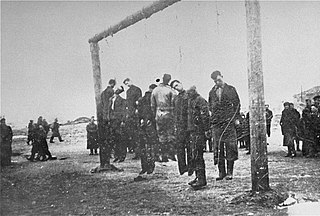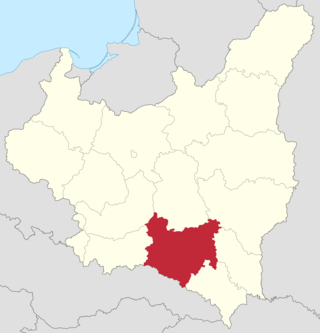
Lviv ) is the largest city in western Ukraine, and the sixth-largest in Ukraine, with a population of 717,273. It serves as the administrative centre of Lviv Oblast and Lviv Raion, and is one of the main cultural centres of Ukraine. Lviv also hosts the administration of Lviv urban hromada. It was named in honour of Leo, the eldest son of Daniel, King of Ruthenia.

Jan Łukasiewicz was a Polish logician and philosopher who is best known for Polish notation and Łukasiewicz logic. His work centred on philosophical logic, mathematical logic and history of logic. He thought innovatively about traditional propositional logic, the principle of non-contradiction and the law of excluded middle, offering one of the earliest systems of many-valued logic. Contemporary research on Aristotelian logic also builds on innovative works by Łukasiewicz, which applied methods from modern logic to the formalization of Aristotle's syllogistic.

Uzhhorod is a city and municipality on the Uzh River in western Ukraine, at the border with Slovakia and near the border with Hungary. The city is approximately equidistant from the Baltic, the Adriatic and the Black Sea making it the most inland city in this part of Europe. It is the administrative center of Zakarpattia Oblast (region), as well as the administrative center of Uzhhorod Raion (district) within the oblast. Population: 115,449.

Lviv Polytechnic National University is the largest scientific university in Lviv, Ukraine. Since its foundation in 1816, it has been one of the most important centres of science and technological development in Central Europe. In the interbellum period, the Polytechnic was one of the most important technical colleges in Poland, together with the Warsaw Polytechnic. In 2020, Lviv Polytechnic was ranked globally among the top 1000 universities according to Times Higher Education. As of 2019, there were approximately 35,000 students in the university.

An oblast ; PL області, oblasti) in Ukraine, sometimes translated as region or province, is the main type of first-level administrative division of the country. Ukraine's territory is divided into 24 oblasts, as well as one autonomous republic and two cities with special status. Ukraine is a unitary state, thus the oblasts do not have much legal scope of competence other than that which is established in the Ukrainian Constitution and devolved by law. Articles 140–146 of Chapter XI of the constitution deal directly with local authorities and their competence.

The University of Lviv, presently the Ivan Franko National University of Lviv, is the oldest institution of higher learning in present-day Ukraine dating from 1661 when John II Casimir, King of Poland, granted it its first royal charter. Over the centuries, it has undergone various transformations, suspensions, and name changes that have reflected the geopolitical complexities of this part of Europe. The present institution can be dated to 1940. It is located in the historic city of Lviv in Lviv Oblast of Western Ukraine.

Kadiivka or Stakhanov is a city in Alchevsk Raion, Luhansk Oblast, Ukraine. It is located on the Komyshuvakha river, a tributary of the Luhan.

The Lwów Ghetto was a Nazi ghetto in the city of Lwów in the territory of Nazi-administered General Government in German-occupied Poland.

Lviv is an administrative center in western Ukraine with more than a millennium of history as a settlement, and over seven centuries as a city. Prior to the creation of the modern state of Ukraine, Lviv had been part of numerous states and empires, including, under the name Lwów, Poland and later the Polish–Lithuanian Commonwealth; under the name Lemberg, the Austrian and later Austro-Hungarian Empires; the short-lived West Ukrainian People's Republic after World War I; Poland again; and the Soviet Union. In addition, both the Swedes and the Ottoman Turks made unsuccessful attempts to conquer the city.

Lwów Voivodeship was an administrative unit of interwar Poland (1918–1939). Because of the Nazi-Soviet invasion of Poland in accordance with the secret Molotov–Ribbentrop Pact, it became occupied by both the Wehrmacht and the Red Army in September 1939. Following the conquest of Poland however, the Polish underground administration existed there until August 1944. Only around half of the Voivodeship was returned to Poland after the war ended. It was split diagonally just east of Przemyśl; with its eastern half, including Lwów itself, ceded to the Ukrainian SSR at the insistence of Joseph Stalin during the Tehran Conference confirmed at the Yalta Conference of 1945.

Baron Otto Gustav von Wächter was an Austrian lawyer, Nazi politician and a high-ranking member of the SS, a paramilitary organisation of the Nazi Party. During the occupation of Poland in World War II, he was the governor of the district of Kraków in the General Government and then of the District of Galicia. Later, in 1944, he was appointed as head of the German Military Administration in the puppet Italian Social Republic. During the last two months of the war, he was responsible for the non-German forces at the Reich Security Main Office (RSHA) in Berlin.

Wołyń Voivodeship or VolhynianVoivodeship was an administrative region of interwar Poland (1918–1939) with an area of 35,754 km², 22 cities, and provincial capital in Łuck. The voivodeship was divided into 11 districts (powiaty). The area comprised part of the historical region of Volhynia. At the end of World War II, at the insistence of Joseph Stalin and the Soviet Union during the Tehran Conference of 1943, Poland's borders were redrawn by the Allies. The Polish population was forcibly resettled westward; and the Voivodeship territory was incorporated into the Ukrainian SSR of the Soviet Union. Since 1991 it has been divided between the Rivne and Volyn Oblasts of sovereign Ukraine.

Administrative divisions development in Ukraine reviews the history of changes in the administrative divisions of Ukraine, in chronological order.

During its existence from 1919 to 1991, the Ukrainian Soviet Socialist Republic consisted of many administrative divisions. Itself part of the highly centralized Soviet Union, sub-national divisions in the Ukrainian SSR were subordinate to higher executive authorities and derived their power from them. Throughout the Ukrainian SSR's history, other national subdivisions were established in the republic, including guberniyas and okrugs, before finally being reorganized into their present structure as oblasts. At the time of the Ukrainian SSR's independence from the Soviet Union, the country was composed of 25 oblasts (provinces) and two cities with special status, Kiev, the capital, and Sevastopol, respectively.
The following gallery displays the official coats of arms of the 27 oblasts, autonomous republics and cities with special status of Ukraine:
The following is a timeline of the history of the city of Lviv, Ukraine.

Luhansk Oblast Football Federation (LOFF) is a football governing body in the region of Luhansk Oblast, Ukraine. The federation is a collective member of the Football Federation of Ukraine.













